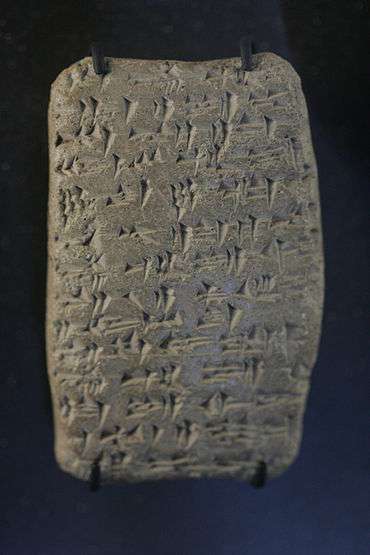MÁ

Amarna letters versions have the lower horizontal across all 3-verticals.
Photo EA 153, "Ships on Hold", , line 10, (7 lines from bottom), GIŠ.MÁ,
Also: EA 245, (reverse, line 4) .

The cuneiform sign MÁ, the sumerogram (capital letter (majuscule)) is the sign for English language "ship", or "boat", Akkadian language eleppu.[1] When written in cuneiform texts, MÁ is preceded by the determinative for items made of wood, namely GIŠ, (GIŠ (wood Sumerogram). For ship, or boat it is written as: GIŠ.MÁ, or GIŠ.MÁ, ![]()
![]()
As examples of words using GIŠ from the Epic of Gilgamesh, giš (cuneiform), lists 16-uses of "wood-related" words, among them Akkadian eleppu, for "ship".[2]
Some of the Amarna letters using the sumerogram for ship, or boat, are Amarna letters: EA 86, EA 153, EA 149, and EA 245. In the Epic of Gilgamesh, Tablet XI (chapter) (the Flood Story) uses the ship/boat sumerogram; elsewhere Gilgamesh is taken by boat in other chapters of the Epic.
See also
References
- ↑ Parpola, 197l. The Standard Babylonian Epic of Gilgamesh, Glossary, pp. 119-145, eleppu, p. 124.
- ↑ Parpola, 197l. The Standard Babylonian Epic of Gilgamesh, Glossary and Indices, Logograms and Their Readings, pp. 117-18, p. 117.
- Parpola, Simo, with Mikko Luuko, and Kalle Fabritius (1997). The Standard Babylonian, Epic of Gilgamesh. The Neo-Assyrian Text Corpus Project. ISBN 951-45-7760-4. (Volume 1) in the original Akkadian cuneiform and transliteration; commentary and glossary are in English
External links
- Amarna letter EA 153-(Obverse), line 10 (7th line from bottom).
- Amarna letter EA 245-(Reverse), line 4(=line 28) (4th line from top-of-reverse).